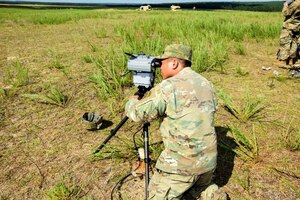By Leon Price, Airborne and Special Operations Test
Directorate, U.S. Army Operational Test Command
FORT BRAGG, N.C., Aug. 25, 2017 — Forward observers --
experts in calling for artillery and mortar fire and directing that ordnance
onto enemy targets -- hit the mark in testing a new piece of targeting
equipment here recently.
Soldiers with Headquarters and Headquarters Battery, 2nd
Battalion, 319th Field Artillery Regiment, perform a combat equipment airborne
jump with the new Joint Effects Targeting System -- JETS -- during operational
testing at Fort Bragg, N.C., June 15, 2017. Once on the ground, soldiers test
the system to ensure it still functions. Army photo
"Black Falcon" Army paratroopers of Headquarters
and Headquarters Battery, 2nd Battalion, 319th Field Artillery Regiment, tested
the effectiveness and durability of the Joint Effects Targeting System, a
modular, soldier-portable, handheld, day/night, all-weather, target
observation, location and designation system.
JETS components include a handheld target location module, a
laser marker module and a precision azimuth vertical angle module, all items
mounted atop a tripod.
Collecting Data
Army Sgt. 1st Class Ryan Orouke, a test noncommissioned
officer with the U.S. Army Operational Test Command's Airborne and Special
Operations Test Directorate, said JETS testing collects data to determine the
system’s suitability, reliability and survivability when conducting static line
airborne operations, in a door bundle configuration for airdrops.
HHB troopers spent four days in New Equipment Training from
the Program Manager Soldier Precision Targeting Devices office out of Fort Belvoir,
Virginia.
Army Sgt. 1st Class Juan Cruz, assistant JETS test NCO, said
that NET places the soldiers in practical exercises to test the equipment.
After NET validation, Orouke said the "Black
Falcons" put JETS through its paces by performing seven combat equipment
jumps and several door bundle drops, making sure that JETS still functions
after it reaches the ground.
Army Pvt. 1st Class Preshelemiah Hitgano, of Headquarters
and Headquarters Battery, 2nd Battalion, 319th Field Artillery Regiment, sets
up the Joint Effects Targeting System -- JETS -- to check that it functions
during recent airdrop testing at Fort Bragg, N.C., June 15, 2017. JETS testing
will continue into 2018 at several military installations. Army photo
After each airborne operation, forward observers assembled
the equipment, and began identifying and designating enemy personnel and
vehicle targets in day and night conditions.
Targets were arrayed over rolling terrain from 800 meters to
over 2,500 meters away. Test data was then gathered to prepare a report, so
senior Army leaders can make procurement decisions on JETS.
Testing
"Operational testing provides soldiers the opportunity
to use, work with and offer up their suggestions on pieces of equipment that
can impact development of systems that future soldiers will use in
combat," said Army Col. Brad Mock, the director of Army Airborne testing.
Upon completion of testing, JETS could potentially be issued
to Army light and airborne artillery forces worldwide.
JETS testing will continue into 2018 at several military
installations.

No comments:
Post a Comment